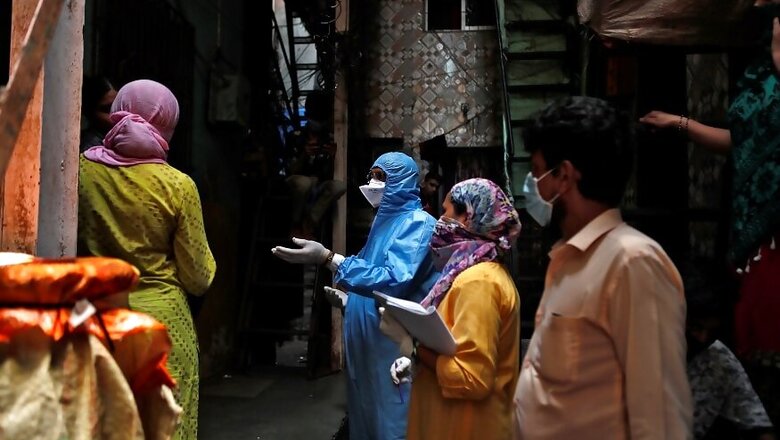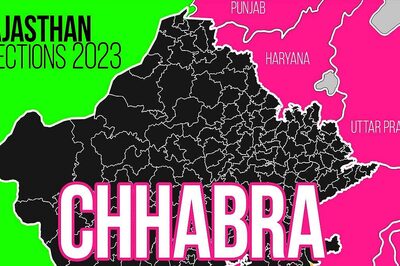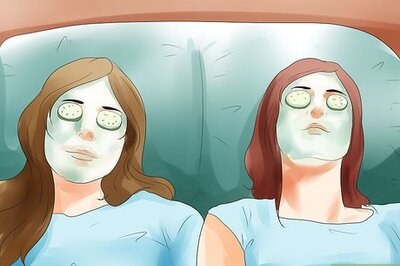
views
In the narrow alleys and tiny, crammed shanties of one of the world's largest slums, doctors and civic officials are aggressively screening and tracing contacts. A 5,000-odd workforce including municipality officials, doctors, nurses and volunteers had been tirelessly working to get the ‘Covid hotspot’ tag off Dharavi. And slowly but surely the area is succeeding. The tightly packed lanes of Dharavi are finally painting a picture of hope.
A steady decline in the number of cases since the beginning of June is a testament to that. From the days when Dharavi was hitting the headlines for recording 80-90 cases a day in the beginning of May, the area has now started to report an average of just 20 cases a day since the start of June. June 8 recorded 12 cases, June 7 saw 13 and June 6 the lowest with 10 cases . In addition, not a single death has been registered since May 30.
Touted as the hotbed of Covid-19 in Mumbai, the area has so far recorded a total of 1,924 cases with 71 deaths. It recorded its first case on April 1 when a 56-year-old man from Baliga Nagar was infected with the novel coronavirus and died hours later. Since then, it had been a steady rise and an uphill task for two months. A slew of measures were put together to trace, test and isolate. But the demography of the place and mindsets of people were the biggest challenge.
“10-12 people live in a single chawl unit and hutment in Dharavi. There are societies too but they also tend to be overcrowded. So we all know that social distancing is not an option in Dharavi. We worked our way in controlling the spread of the virus by accepting that truth. That was first and foremost,” says Kiran Dighavkar, assistant municipal commissioner of G North ward under which Dharavi falls. “Adding to that is convincing people, gaining their trust, getting them to cooperate. It was not easy. Not many would come out and reveal their contact history, not many would agree to leave their homes to go to a quarantine centre. It required them trusting us, which we gained over a period of time.”
The Brihanmumbai Municipal Corporation (BMC), which started aggressively screening and isolating patients in the slum cluster comprising 8 lakh people spread over 2.5 sq km, feels winning the Dharavi battle against Covid-19 is the first and most important step towards winning the Mumbai battle against the virus. Besides a huge migrant population and a lot of native daily wagers, Dharavi is also home to small enterprises of leather, pottery and textiles.
The numbers here are quite telling. According to the BMC, approximately 6.5 lakh people have been screened in Dharavi over the last two months. That includes over 5 lakh door-to-door screenings at about 47,000 dwellings, over 8,200 senior citizens being surveyed, 15,000 people screened via mobile fever clinics, over 800 via municipal dispensaries and many others who were screened at several private clinics.
Of the 1,924 people who have turned positive, more than 960 have been discharged, taking the discharge rate to over 50% in Dharavi. The number of tests conducted here is approximately 7,000, which the BMC says is targeted testing of contacts, especially of those exhibiting symptoms.
“Our fever clinics, mobile dispensaries and door-to-door surveys are success stories that helped us isolate high-risk and low-risk contacts without wasting much time. Of course it required a lot of convincing and counselling. We are not dealing with many educated, aware people. We took it upon ourselves to create awareness and communicate openly. The importance of hygiene, washing hands regularly, etc, were communicated. Problem areas were mapped and more emphasis was given in hotbed areas within Dharavi,” said a BMC official.
Some of the areas in Dharavi which witnessed maximum cases are Matunga Labour camp, Kumbhar Wada, Mukund Nagar, 90-feet Road, Dharavi Cross Road, Kunchi Korve Nagar to name a few.
Tracing and isolating the contacts was of utmost priority for the officials as a majority of the people here live in tiny, crammed structures and share toilets and boundary walls. The community toilets were disinfected regularly. Uprooting people, especially contacts, was non-negotiable.
BMC has set up 12 institutional quarantine facilities for Dharavi with a bed capacity of 3,840. A total of 8,500 have been quarantined in these institutions so far and 38,000 have been home quarantined with stamps who are regularly monitored. Many schools, auditoriums, hotels and sports complexes near the area were converted into quarantine centres. “We conduct yoga sessions and laughter therapy, even singing and gaming sessions for the citizens in these quarantine centres. We ensure that we make them feel at home. The Dharavi story is a combined effort of officials and citizens. We are flattening the curve and it’s because of the focused approach and sustained effort we took in controlling the spread in perhaps the most vulnerable area of Mumbai or even the country,” added Dighavkar.



















Comments
0 comment